Abstract
To study the relationship between carbohydrate-specific amebic cytoadherence and ameba-mediated cytotoxicity, we measured Entamoeba histolytica trophozoite-mediated cytolysis directed against a panel of four Chinese hamster ovary (CHO) cell lines that have defined alterations in their glycosylation patterns. We recently measured amebic trophozoite adherence to this panel of CHO cells and showed that trophozoites bind variant cells (RICR 15B), which are deficient in Asn-linked N-acetyllactosamine units, at 12% of the level observed for wild-type cells (E. Li, A. Becker, and S. L. Stanley, J. Exp. Med 167:1725-1730, 1988). Using a 51Cr release assay to measure trophozoite-mediated cytolysis, we demonstrate in this study that RICR 15B cells are less susceptible to trophozoite-mediated cytolysis than are wild-type cells. In addition, we found that N-acetyllactosamine, which inhibits trophozoite adherence to CHO cells, also inhibited trophozoite-mediated cytolysis of wild-type cells. These studies indicate that surface carbohydrates on target cells can influence susceptibility to ameba-mediated cytotoxicity. This panel of CHO cells provides a useful model system for investigating the role of glycoconjugates in mediating amebic interactions with mammalian cells.
Full text
PDF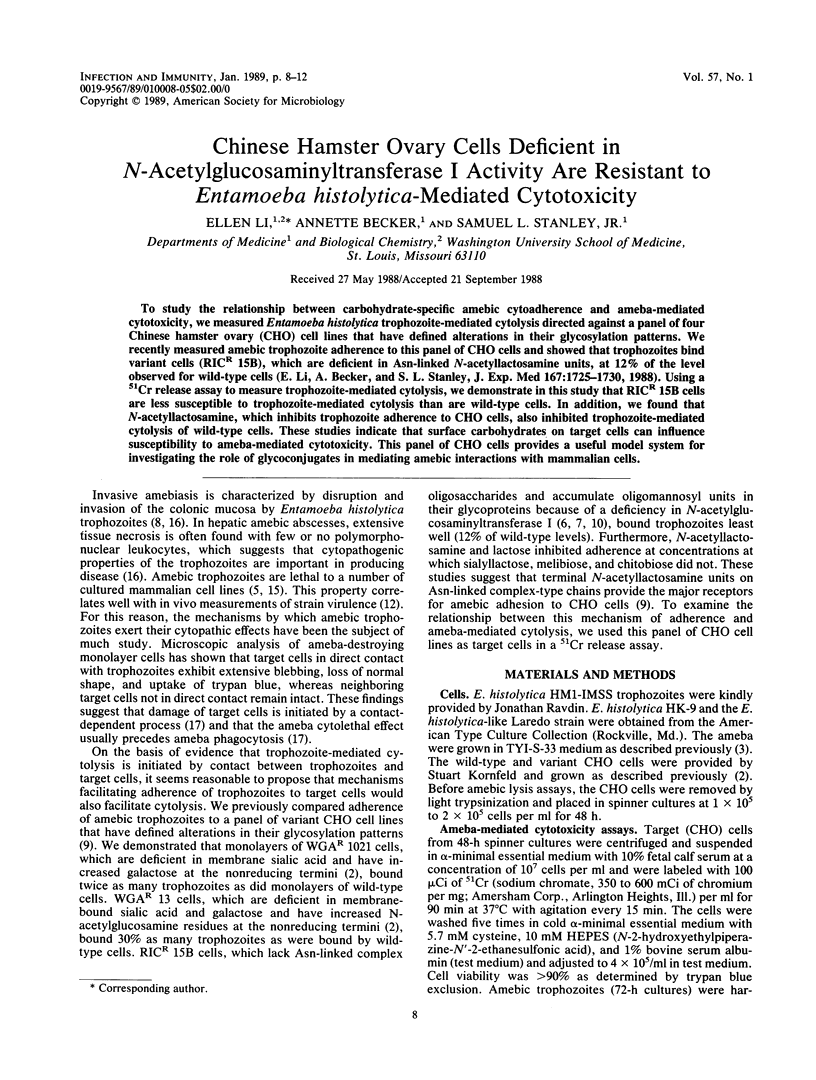
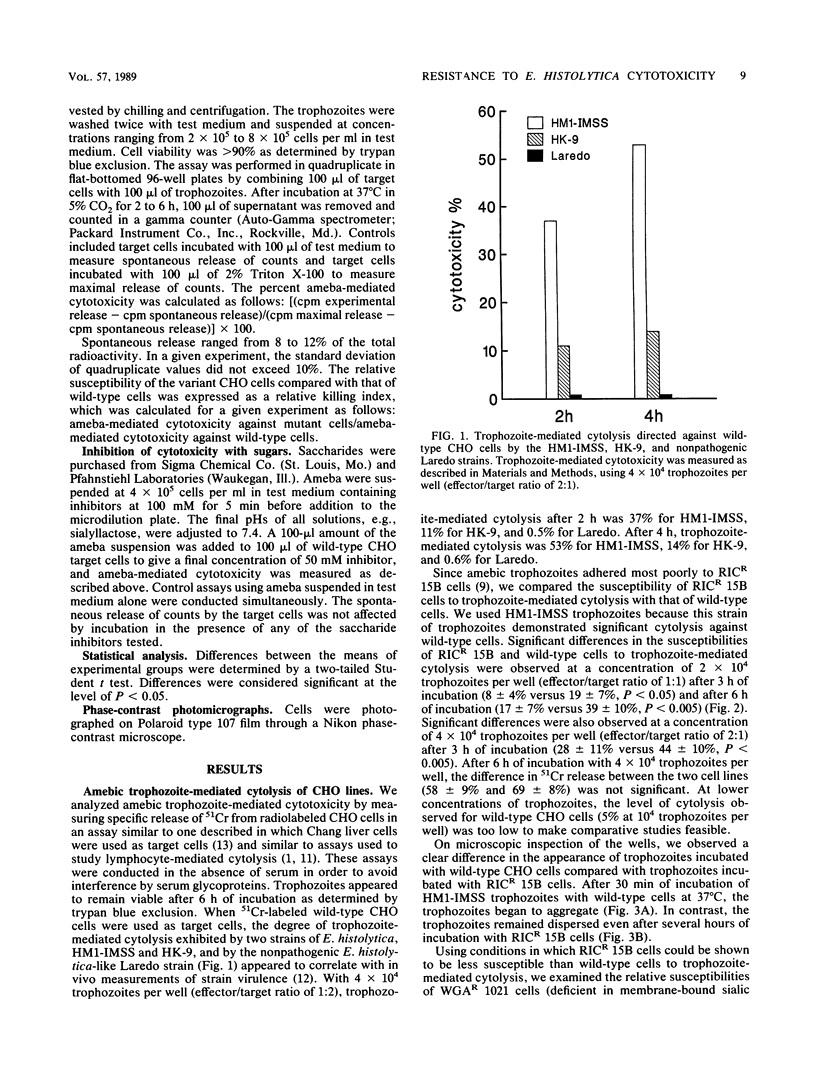
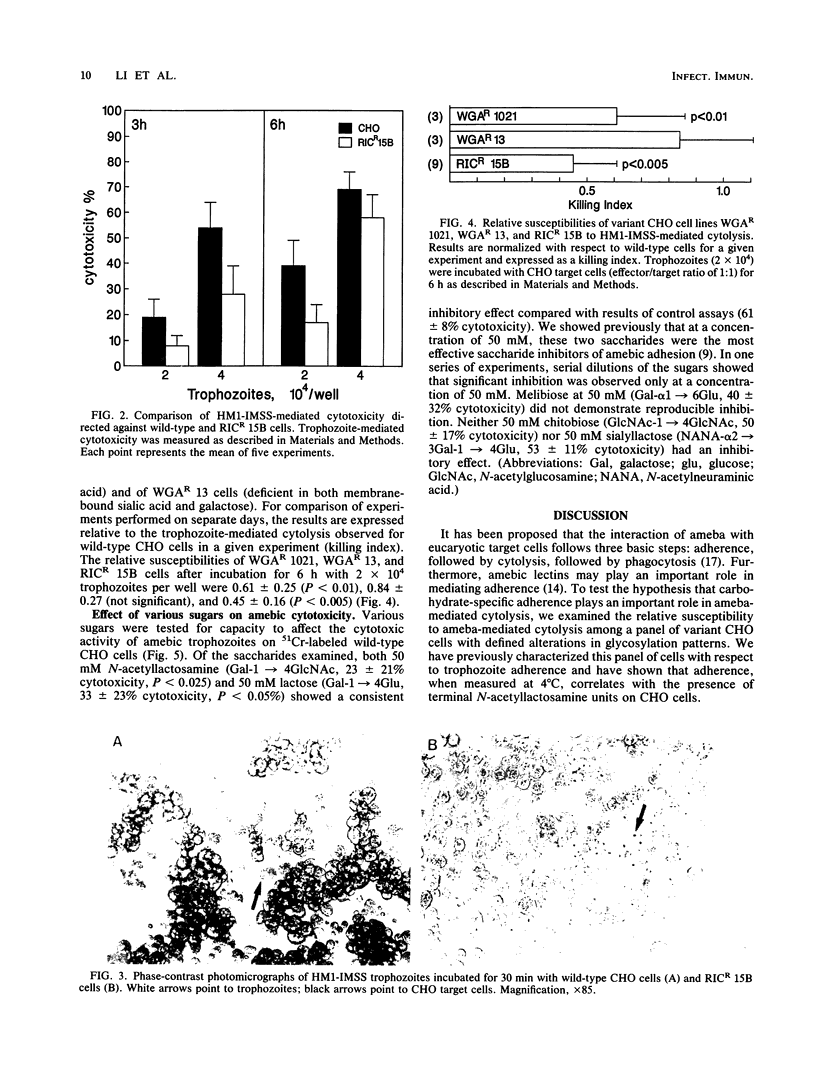
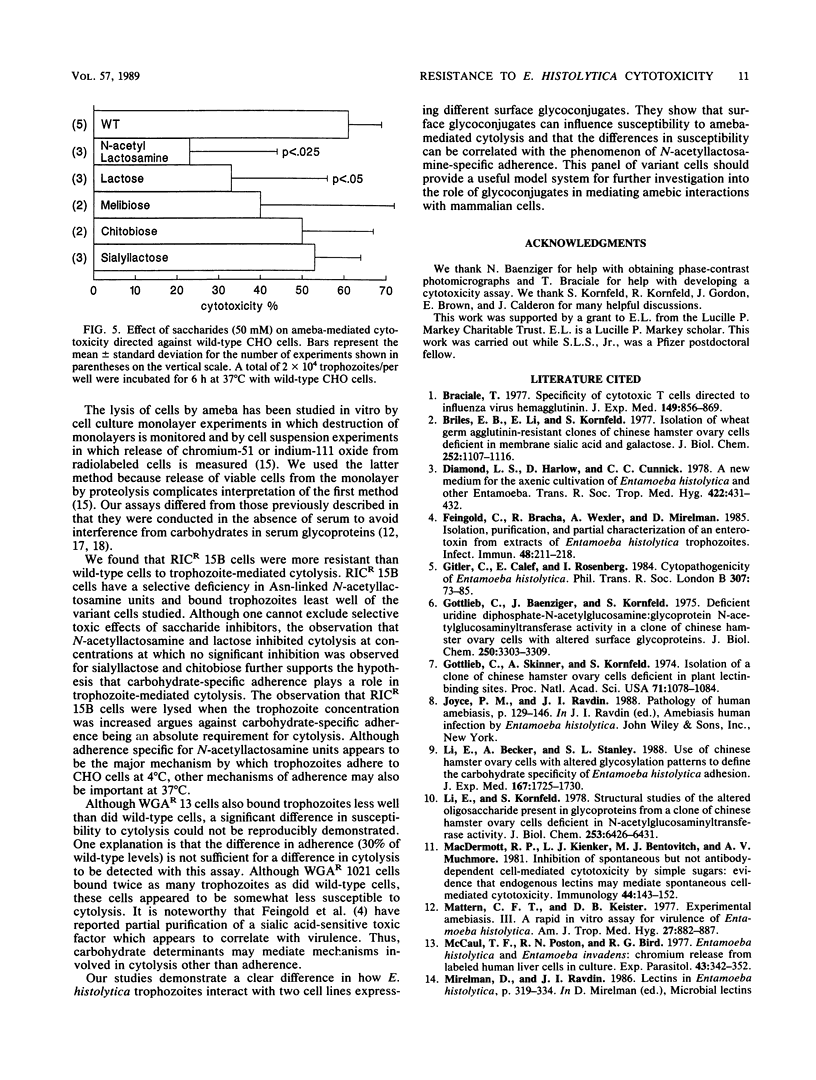
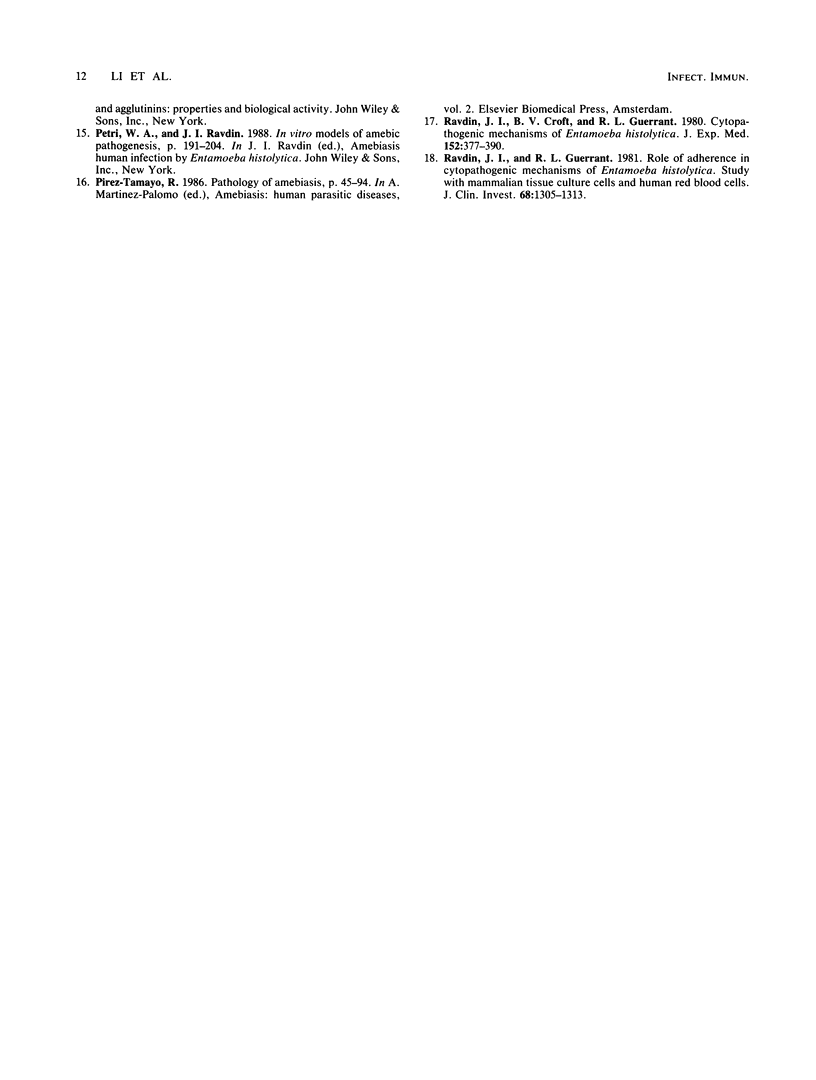
Images in this article
Selected References
These references are in PubMed. This may not be the complete list of references from this article.
- Braciale T. J. Specificity of cytotoxicity T cells directed to influenza virus hemagglutinin. J Exp Med. 1979 Apr 1;149(4):856–869. doi: 10.1084/jem.149.4.856. [DOI] [PMC free article] [PubMed] [Google Scholar]
- Briles E. B., Li E., Kornfeld S. Isolation of wheat germ agglutinin-resistant clones of Chinese hamster ovary cells deficient in membrane sialic acid and galactose. J Biol Chem. 1977 Feb 10;252(3):1107–1116. [PubMed] [Google Scholar]
- Diamond L. S., Harlow D. R., Cunnick C. C. A new medium for the axenic cultivation of Entamoeba histolytica and other Entamoeba. Trans R Soc Trop Med Hyg. 1978;72(4):431–432. doi: 10.1016/0035-9203(78)90144-x. [DOI] [PubMed] [Google Scholar]
- Feingold C., Bracha R., Wexler A., Mirelman D. Isolation, purification, and partial characterization of an enterotoxin from extracts of Entamoeba histolytica trophozoites. Infect Immun. 1985 Apr;48(1):211–218. doi: 10.1128/iai.48.1.211-218.1985. [DOI] [PMC free article] [PubMed] [Google Scholar]
- Gitler C., Calef E., Rosenberg I. Cytopathogenicity of Entamoeba histolytica. Philos Trans R Soc Lond B Biol Sci. 1984 Nov 13;307(1131):73–85. doi: 10.1098/rstb.1984.0110. [DOI] [PubMed] [Google Scholar]
- Gottlieb C., Baenziger J., Kornfeld S. Deficient uridine diphosphate-N-acetylglucosamine:glycoprotein N-acetylglucosaminyltransferase activity in a clone of Chinese hamster ovary cells with altered surface glycoproteins. J Biol Chem. 1975 May 10;250(9):3303–3309. [PubMed] [Google Scholar]
- Gottlieb C., Skinner A. M., Kornfeld S. Isolation of a clone of Chinese hamster ovary cells deficient in plant lectin-binding sites. Proc Natl Acad Sci U S A. 1974 Apr;71(4):1078–1082. doi: 10.1073/pnas.71.4.1078. [DOI] [PMC free article] [PubMed] [Google Scholar]
- Li E., Becker A., Stanley S. L., Jr Use of Chinese hamster ovary cells with altered glycosylation patterns to define the carbohydrate specificity of Entamoeba histolytica adhesion. J Exp Med. 1988 May 1;167(5):1725–1730. doi: 10.1084/jem.167.5.1725. [DOI] [PMC free article] [PubMed] [Google Scholar]
- Li E., Kornfeld S. Structure of the altered oligosaccharide present in glycoproteins from a clone of Chinese hamster ovary cells deficient in N-acetylglucosaminyltransferase activity. J Biol Chem. 1978 Sep 25;253(18):6426–6431. [PubMed] [Google Scholar]
- MacDermott R. P., Kienker L. J., Bertovich M. J., Muchmore A. V. Inhibition of spontaneous but not antibody-dependent cell-mediated cytotoxicity by simple sugars: evidence that endogenous lectins may mediate spontaneous cell-mediated cytotoxicity. Immunology. 1981 Sep;44(1):143–152. [PMC free article] [PubMed] [Google Scholar]
- Mattern C. F., Keister D. B., Caspar P. A. Experimental amebiasis. III. A rapid in vitro assay for virulence of Entamoeba histolytica. Am J Trop Med Hyg. 1978 Sep;27(5):882–887. [PubMed] [Google Scholar]
- McCaul T. F., Poston R. N., Bird R. G. Entamoeba histolytica and Entamoeba invadens: chromium release from labeled human liver cells in culture. Exp Parasitol. 1977 Dec;43(2):342–352. doi: 10.1016/0014-4894(77)90039-x. [DOI] [PubMed] [Google Scholar]
- Ravdin J. I., Croft B. Y., Guerrant R. L. Cytopathogenic mechanisms of Entamoeba histolytica. J Exp Med. 1980 Aug 1;152(2):377–390. doi: 10.1084/jem.152.2.377. [DOI] [PMC free article] [PubMed] [Google Scholar]
- Ravdin J. I., Guerrant R. L. Role of adherence in cytopathogenic mechanisms of Entamoeba histolytica. Study with mammalian tissue culture cells and human erythrocytes. J Clin Invest. 1981 Nov;68(5):1305–1313. doi: 10.1172/JCI110377. [DOI] [PMC free article] [PubMed] [Google Scholar]



